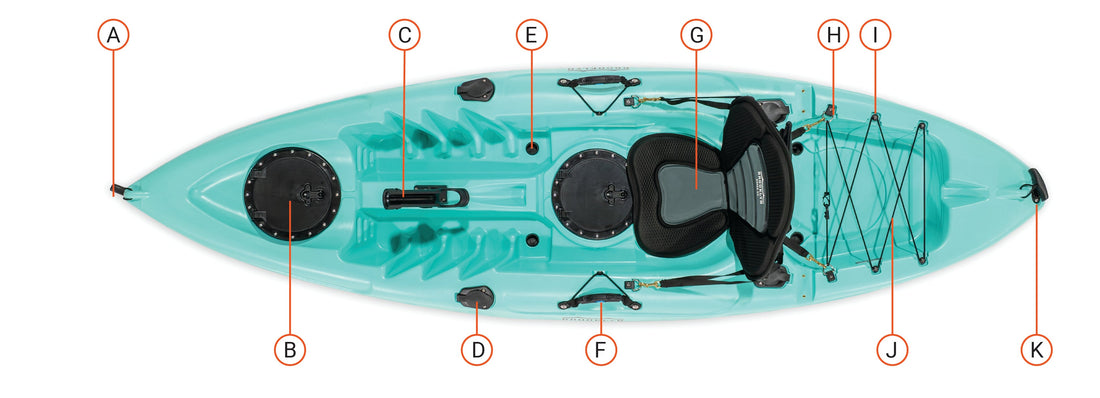Looking for a new way to explore the environment around you? Kayaking is a low-barrier, engaging way to do so! You’re able to access multiple bodies of water, and get a mind and body work out while you’re at it. It’s also great for solo-trips or bonding with a group.
Compared to motorized boats, kayaks are relatively simple vessels to learn, transport, and maneuver. As you start out kayaking, there are a few basic parts and features to familiarize yourself with so your paddling adventures can go as smoothly as possible.
Basic Kayak Parts
While kayaks these days are highly customizable depending on what you like doing with it, there are some common attributes that will be consistent across most models. Being able to identify the different kayak parts will make it easier for you to find what you’re looking for in a kayak. Whether you’re speaking with a sales associate or shopping online, it helps to know which part is which.
First, you’ll want to familiarize yourself on the kayak. The kayak’s “bow” is the part of the boat that points ahead of you, so it will be what you see when you’re facing forward in the kayak. The “stern,” in turn, is behind you and faces whatever you just passed. These two phrases may be used when describing where other features are positioned, in addition to the terms “port” and “starboard” which are left and right, respectively.
After you’ve correctly oriented yourself on the kayak, here are some more common kayak parts you’ll become familiar with:
- Deck: this refers to the topside of the kayak. Everything outside of the water is the deck, and both sit-on and sit-in kayaks have decks, even if the seats are in different places.
- Hull: this is the opposite of the deck, it’s the underside of the kayak. They’re usually curved to be more hydrodynamic and sit submerged in the water when you’re in it.
- Cockpit: simply put, this is what your body “sits in” in a sit-in kayak. It is a hollowed-out section of the hull that has room for a seat and your legs. A sit-on-top kayak still has a cockpit, it’s just not as embedded in the hull. The sit-on cockpits still usually have grooves for the legs and the seat is in that section, your legs just aren’t covered. The cockpit points you towards the bow of the boat.
- Seat: these can look slightly different in sit-in and sit-on kayaks, but in both styles of boats they are situated in the cockpit facing the bow. Some have backs, some are more bench-like, so be sure to pick one that best supports you when paddling. If you can try the seat(s) before you buy your kayak, that will give you the best idea of what you like.
- Foot braces and Foot wells: foot braces are adjustable pegs that reside within the foot wells to add extra stability. Foot wells are built into the kayak to give more support and sometimes included on sit-in kayaks in the cockpit to provide extra stability while paddling. Not all kayaks have these features, but you might like them for additional support when adjusting to balancing in a kayak.
- Deck Lines: these are straps positioned on the deck towards both the bow and stern of the kayak. They can be stretchy and made of bungee cords, or static and more rigid. They are useful in securing a low-profile piece of equipment or used as a hold when getting in or out of the boat.
- Hatch: this is a really helpful feature on a kayak, as it gives you a secure place to put any extra gear or supplies while out on the water. The kayak hatch is the portal to a storage compartment in the hull of a kayak. Since kayaks are smaller, the extra storage is a great feature to have onboard for longer paddling sessions.
- Scupper Holes or Drain Plugs: as the name slightly implies, these are holes that allow excess water to drain out of the kayak. These are helpful features especially if you paddle in colder waters. It also makes drying out your kayak easier after you’ve finished your session.
You can use a kayak for lots of different types of activities, from fishing to whitewater rafting, so there may be extra features that customize the boat to those conditions. As long as you have an idea of the basics, though, you’re set to understand how any add-ons or customizations impact the kayaking experience. Now all that’s left is to get your kayak out on the water and enjoy the experience!

